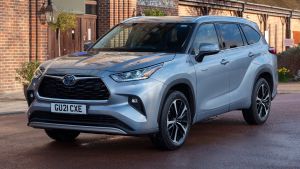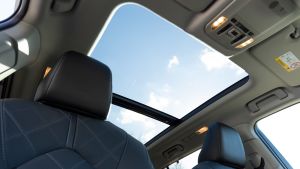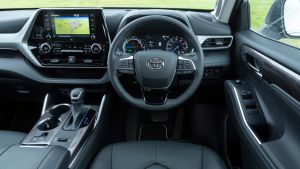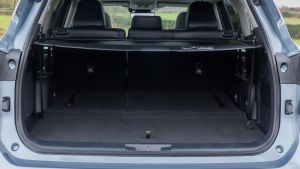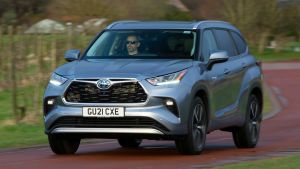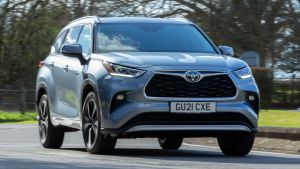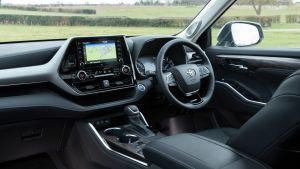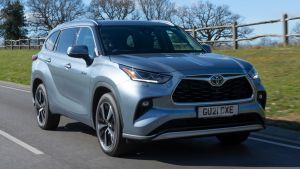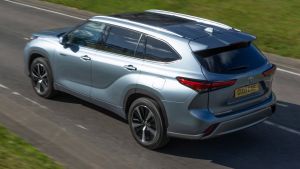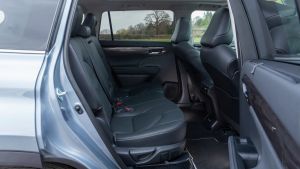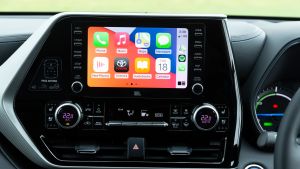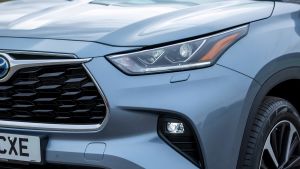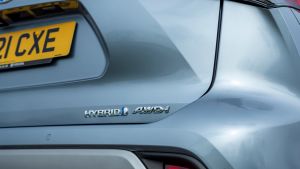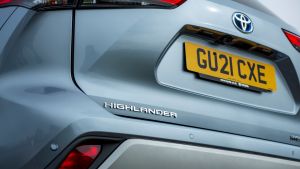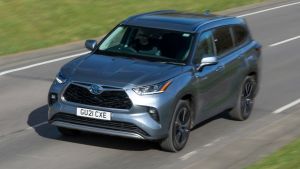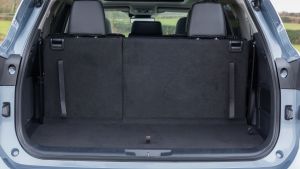Verdict
The Toyota Highlander holds a strong hand when graded against some of the more everyday requirements of a full-size family SUV: versatility, practicality and very competitive running costs. However, though it’s the most affordable point of entry into a car of this size this side of a SsangYong, the difference isn’t vast compared with some premium rivals that are built with the European market more in mind.
The newest Toyota on sale in Britain is one with a pedigree formed by strong sales over the last two decades, albeit away from the European market.
Some 21 years after its introduction in the United States, Australia and Japan, the Highlander has landed at a time of high sales of these sorts of vehicles in the UK. Full-size SUVs are popular and profitable, but the market is dominated by upmarket badges. Toyota thinks that with over 20 years of experience elsewhere under its belt, it could be perfectly placed to be a mainstream upstart.
- SEE MORE Best large SUVs on sale 2021
At 4,966mm long, 1,930mm wide and 1,755 tall, the Highlander is significantly larger than the RAV4 it shares its platform with - the GA-K version of Toyota’s TNGA Architecture. It’s not the only large SUV in Toyota’s UK line-up, though; the Land Cruiser still goes on, but the Highlander is a completely different proposition. Using its more modern platform, and only available with a hybrid drivetrain, it’s a more road-focused large family SUV compared with the brand’s tough and taller off-roader.
Two versions have been prepared for the UK market. The Highlander Excel will account for the lion’s share of sales, and is priced from £50,595. Standard comfort and convenience equipment includes black leather upholstery on all seven of the Highlander’s seats, with the driver and front passenger receiving seat heaters, three-zone climate control, a heated steering wheel, a panoramic roof and a power-operated boot opening. Puddle lights, front and rear parking sensors and a reversing camera are also fitted.
Cabin technology includes an eight-inch touchscreen infotainment unit with navigation, Apple CarPlay and Android Auto, an 11 speaker sound system from JBL and a wireless smartphone charger hidden in the central storage compartment; the analogue instruments are supplanted with a seven-inch driver information display. There’s a plusher Excel Premium trim, too, from £52,575. This introduces a head-up display, a top-down parking camera, heated rear seats and ventilated fronts, among other additions.
Both versions of the Highlander feature a 2.5-litre petrol engine, small battery and electric motor system, which combine to create a power-split hybrid system. This means that the Highlander can run on electric power only over short distances, but the electric motors also drive the wheels when the engine is brought into play, with the petrol powerplant acting as a generator for the battery.
With a platform and powertrain setup modified from the RAV4, there are strong similarities between the mid-size and full-size Toyota SUVs from behind the wheel, the most plainly obvious of which is that buyers will have to get used to the quirks of a CVT gearbox. Thankfully, torque off the line is strong thanks to the subtle punch of the electric motor, so getting the two-tonne Highlander on the move doesn’t require a strong, rev-inducing stomp of the accelerator.
Once you’re up to town speed, you can slip the Highlander into the EV mode via a button near the chunky gear selector. While it’s not a fully-electric drive mode anywhere near as in-depth as on the plug-in hybrid version of the RAV4, it does come in useful and is available readily. You can slink around city streets in silence and at speeds up to 38mph, before the petrol engine is brought into play to assist the small battery. It will automatically trip into EV mode at cruising speed, too, shutting down the engine for brief periods.
As a result, on the motorway or out on countryside A and B-roads, the engine’s marriage to a CVT transmission isn’t as intrusive as you might otherwise think - it only introduces typical rev-holding up steep hills and if you go full throttle, and the noise coming from the engine bay is well suppressed. It’s quiet on the motorway - the buff front end and huge mirrors mean that you pick up a little wind noise more than anything else.
Performance isn’t sharp but is adequate, with 0-62mph coming up in 8.3 seconds, and top speed rated at 111mph. The Highlander even has a Sport drive mode, but much like the paddles behind the steering wheel, which are supposed to create artificial steps in the CVT’s fluid gear ratio, it feels largely pointless and does little to change the driving experience. It’s best left in Normal, or even the Eco mode; these provide more than enough power to get around.
Like most TNGA platformed cars, there’s a sweet spot in ride quality found just beyond low speed. Around town, the Highlander can pick up scars and niggles in the tarmac, but it’s not overly firm. It settles nicely at speed and is extremely comfortable on the motorway, but the weight means that in spite of the smooth ride, the body is prone to a little wallowing on bendier and undulating B-road tarmac.
However, while it’s certainly not being pitched as a sporty large SUV, it does have steering to that effect. So that means it’s precise and easy to place on the road, defying its size in a way that some large SUVs struggle to do.
As for fuel economy, Toyota claims between 39.2-39.7mpg, and by and large that’s a number we think is representative of what you’ll get in the real world. According to the on-board trip computer it’s a figure we just eclipsed on our test drive, where we saw a reported 40.6mpg.
Buyers of SUVs of this size and price will demand a quality interior, and the Toyota has its plusses and minuses. We like the quality of the soft-touch plastics at arm height and the veneer trim around the cabin, while the seats are upholstered in soft leather and it all feels exceptionally well built.
It doesn’t feel cutting edge, however. We’ve drawn attention to the eight-inch Touch 2 infotainment system in the past for feeling very dated compared with the systems from rival manufacturers, and this is true of the Highlander’s setup. It’s a shame, because Highlanders in the US are sold with a brand-new, widescreen 12.3-inch system that’s missing in Britain.
What the Highlander lacks in sparkle inside is made up for with exceptional versatility. There are endless storage spaces around the cabin - in the doors, within the dashboard, as well as in the huge central storage bin. Forward and side visibility are great, though the view out of the rear window is a little restricted.
There’s vast amounts of space, too, and the cabin is heavily configurable. The second row can slide 180mm, and pushed all the way back there’s a huge amount of legroom for passengers sitting there.
Coming with seven seats as standard, the third-row can accommodate adults on shorter trips if the sliding second-row is placed in its middle position, which doesn’t compromise space there too badly . It can be pushed all the way up to the front row for very easy access to the rearmost two seats as well, and all seven seats can recline fore and aft for greater comfort.
In five-seat mode the completely flat loading area in the back stands at a very useful 658 litres up to the tonneau cover. The capacity is 1,909 litres up the roof when the second row is folded flat, and even with all seven seats in place there’s enough room left to rival the boot of a supermini, at 332 litres.
For families desiring seven-seats with SUV style, the Highlander makes its case strongly as one of the more versatile large SUVs out there. But, despite the list price undercutting key rivals, it doesn’t translate into a clear cut equation on monthly finance.
On PCP, place a 10 per cent deposit down on a Highlander Excel over 36 months with 10,000 miles, and per month you’ll pay £774. That's a fair bit less than an Audi Q7 will set you back, but it’s a figure that’ll give you food for thought when both the Land Rover Discovery and Volvo XC90 are available in the same ballpark, or even for less.
But, because it’s a hybrid, and because it has CO2 emissions of just 160g/km, the Highlander’s first year VED bill stands at only £530. For private buyers that represents a decent saving on day one of ownership, when some petrol rivals will cost well into four figures to tax for the first time. But mild hybrid diesels, like the Volvo XC90 B5 (D), run it much closer, at £830.
| Model: | Toyota Highlander Excel 2.5 Hybrid AWD-i |
| Price: | £50,595 |
| Engine: | 2.5-litre 4cyl petrol hybrid |
| Power/torque: | 244bhp/TBC |
| Transmission: | CVT automatic, four-wheel-drive |
| 0-62mph: | 8.3 seconds |
| Top speed: | 111mph |
| Economy: | 39.2mpg |
| CO2: | 160g/km |
| On sale: | Now |
